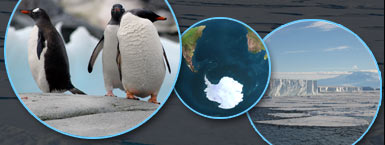Antarctica's Ecosystem

View interactive of
Summer Ecosystem

View interactive of
Winter Ecosystem
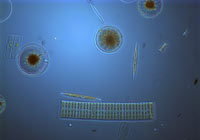
Diatoms like these are at the base of the Antarctic food chain. In summer they use photosynthesis to grow, and multiply into huge populations. (Photo courtesy of Rebecca Gast, WHOI)
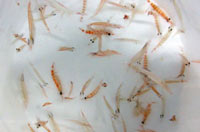
Young (juvenile) krill that were collected in a net. (Woods Hole Oceanographic Institution)
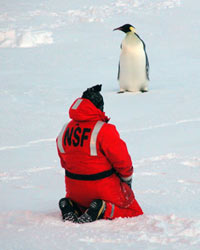
A curious Emperor penguin approaches a technician. (Photo by Peter Wiebe, WHOI)
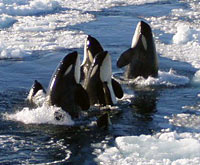
Orcas are toothed whales that hunt large single prey items, such as penguins and seals. (Photo by Mark Dennett, WHOI)
The Circle of Life
Antarctic seas are extremely productive because phytoplankton grows abundantly during the extended daylight of summer and feeds huge populations of krill. Krill, shrimplike crustaceans, are a key animal in this ecosystem, as food for top predators: whales, penguins, and seals. Soft transparent animals called salps also feed on phytoplankton in summer, and form huge swarms that may sometimes replace krill. Winters have little light, no phytoplankton growth, and extremely cold temperatures, but a complex food web links a great variety of ocean animals.
If you are unable to view the interactive, you can download the Flash player for free. Click here »
An Abundance of Life
Much of the ocean around Antarctica is ice-covered for half the year, and the temperature is near freezing all year. Yet the sea here is full of life, from microscopic algae to shrimplike krill to large predators that depend on them. This is one of the most abundant oceans on earth, and its cycle of production is tied to the change in seasons.
Each winter in Antarctica, as the sun disappears and temperatures plunge, ice forms on the sea and extends outward from the continent to cover large areas of ocean. The ice is important to the ecosystem, because microscopic, single-celled algae—the same kinds that drift in the open water as phytoplankton—are trapped inside the ice as it forms and also grow on the ice’s underside. Young krill congregate under the ice all winter, and the algae provides critical food for them when there is not enough light to produce food in the open water. Instead of being a hardship, winter ice lets the krill survive until spring.
In spring, the sea ice melts, releasing the trapped algae into the water. The algae—now living freely as phytoplankton—find all that they need to grow: open water, lots of nutrients (compounds like plant fertilizer, stirred up from deeper water by wind and ocean circulation), and intense sunshine.
What happens next is a bloom, or population explosion, of phytoplankton in the water. Animals, especially krill, consume this abundant food supply, and multiply to astounding levels. Scientists have estimated that the krill in the ocean around Antarctica weigh more than the entire world’s human population. The krill, rich in protein and fat, are food for large numbers of animals at the top of the food chain, including penguins, seals, and whales.
Scientists studying the Antarctic marine ecosystem now know that its high productivity is confined to the edge of the sea ice and a few other areas, rather than everywhere in the Southern Ocean. And that its high productivity may be changing, as the Antarctic climate warms and there is less and less sea ice.
